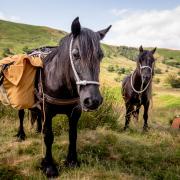Miranda Thompson charts the history of one of our oldest and most prestigious yacht clubs. Mark Gilligan risks a soaking to capture them in action
One of the Lake District’s most treasured institutions is celebrating its 150th anniversary this year. The Royal Windermere Yacht Club is a stalwart both on the Bowness Bay waterfront and the water itself, for without this club the picture-postcard scenes of sleek wooden yachts slicing through a glassy lake or bright dinghies bobbing upon white-crested waves would be unthinkable. As the UK’s only Royal inland yacht club which can count England’s longest lake as its home, it also boasts a rich history unlike any other.
Conceived in 1860 by a like-minded group of Victorian industrialists, the yacht club was then the preserve of the elite who employed professional fishermen from Morecambe Bay to rig and crew their boats. On the shore, members would gather in a room in Bowness’s Old England hotel for meetings and mingling, while on the water races were a popular spectator sport for the local population with many gathering to place bets. In her Golden Jubilee year of 1887 Queen Victoria was ‘graciously pleased to allow the Club to be styled the Royal Windermere Yacht Club.’
This gentleman’s sport was executed in impressive boats which would dwarf today’s craft: the 34ft boat was a popular choice for many, with the smaller 22ft yacht a second-class option. But perhaps one of the most remarkable moments in the club’s history was the introduction of the 17ft keelboat which holds the honour of having been designed uniquely for Lake Windermere. Its creator, prominent club member Percy Crossley conceived the idea of a smaller, easy-to-handle vessel after the larger, more cumbersome Una yacht’s popularity waned.
Club historian John Curtis recounts that the initial response to the proposed yachts from senior club members was that ‘they were a bit small’, yet the class has gone from strength to strength and is now the largest fleet in the club. The boats’ heritage is integral: the oldest boat currently racing is Atholl, built in 1934!
The Crossley legend has also lived on through four members of the family who have held officer positions in the club, the most recent being Gay Crossley who in 2005 became the first female commodore.
In 1870 the sport diversified from using the professional help of crews to be an amateur sport, and has remained so ever since. Today club members include Phil Evans and Steve Goacher, currently National and European champions of the Flying Fifteen class and Andy Tunnicliffe in the GP14 Nationals. In 2007, at the age of 18, Anna Mackenzie was helm in the youngest and first-ever all-women team to win the Mirror Class World Championship.
The club is home to a fleet of six different boat classes, from the grand 17ft and Flying 15 yachts, to the dinghy classes which include RS400, GP14s and Mirrors all of whom regularly compete in local and national competitions; in September this year the club hosted the GP Masters Championships and in October the RS400 Inland Championship.
With staid Victorian values consigned to the past, the club is an excellent example of sailing’s attraction as a family sport. Rear Commodore Richard Thompson explains how the club is dedicated to ‘promoting sailing amongst the younger generations’ and has been since 1949 with the post-war introduction of the Firefly dinghy specifically for more youthful racing.
Not only is there an extremely active younger generation of sailors within the club producing Mirror World Champions, the club also welcomes those wishing to dip their toes into sailing through summer courses, which are open to non-members. As an RYA (Royal Yachting Association) accredited institution, youngsters can spend a week splashing about on Optimist or Laser Pico dinghies, whilst there are also plans afoot for adult courses ranging from absolute beginners to those wishing to learn racing tactics.
In celebration of the club’s sesquicentennial achievement, a glittering June night was spent at Windermere’s Hydro hotel with 144 guests. The historic event was marked on the water by the Celebration 150 Race Day with every boat in the fleet invited to race in commemoration of the club’s history.
The fleet included an original 19ft boat Windar’d II, the only suriviving one in the world, which had travelled all the way from Salcombe in Devon. The summer also saw the publication of a book on the history of the RWYC by Ian Jones which costs �18 and is available from the club.
As for the club’s future, it’s looking bright. Richard Thompson says the essential refurbishment on the jetties is underway as well as plans in progress for the installation of a lift in the purpose-built clubhouse. Meanwhile, long-term plans could see the introduction of a new type of dinghy and, of course, the dedicated commitment of promoting sailing upon one of Britain’s most treasured natural hotspots.
As RWYC members raise a toast to the club at the annual prize-giving dinner on November 6, here’s to the next 150 years!
For more information please visit http://www.royal-windermere.co.uk/


























